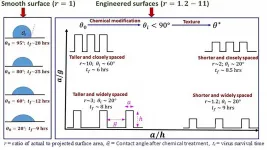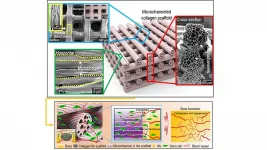(Press-News.org) WASHINGTON, May 4, 2021 -- If a respiratory droplet from a person infected with COVID-19 lands on a surface, it becomes a possible source of disease spread. This is known as the fomite route of disease spread, in which the aqueous phase of the respiratory droplet serves as a medium for virus survival.
The lifespan of the respiratory droplet dictates how likely a surface is to spread a virus. While 99.9% of the droplet's liquid content evaporates within a few minutes, a residual thin film that allows the virus to survive can be left behind.
This begs the question: Is it possible to design surfaces to reduce the survival time of viruses, including the coronavirus that causes COVID-19? In Physics of Fluids, from AIP Publishing, IIT Bombay researchers present their work exploring how the evaporation rate of residual thin films can be accelerated by tuning surfaces' wettability and creating geometric microtextures on them.
An optimally designed surface will make a viral load decay rapidly, rendering it less likely to contribute to the spread of viruses.
"In terms of physics, the solid-liquid interfacial energy is enhanced by a combination of our proposed surface engineering and augmenting the disjoining pressure within the residual thin film, which will speed drying of the thin film," said Sanghamitro Chatterjee, lead author and a postdoctoral fellow in the mechanical engineering department.
The researchers were surprised to discover that the combination of a surface's wettability and its physical texture determine its antiviral properties.
"Continuously tailoring any one of these parameters wouldn't achieve the best results," said Amit Agrawal, a co-author. "The most conductive antiviral effect lies within an optimized range of both wettability and texture."
While previous studies reported antibacterial effects by designing superhydrophobic (repels water) surfaces, their work indicates antiviral surface design can be achieved by surface hydrophilicity (attracts water).
"Our present work demonstrates that designing anti-COVID-19 surfaces is possible," said Janini Murallidharan, a co-author. "We also propose a design methodology and provide parameters needed to engineer surfaces with the shortest virus survival times."
The researchers discovered that surfaces with taller and closely packed pillars, with a contact angle of around 60 degrees, show the strongest antiviral effect or shortest drying time.
This work paves the way for fabricating antiviral surfaces that will be useful in designing hospital equipment, medical or pathology equipment, as well as frequently touched surfaces, like door handles, smartphone screens, or surfaces within areas prone to outbreaks.
"In the future, our model can readily be extended to respiratory diseases like influenza A, which spread through fomite transmission," said Rajneesh Bhardwaj, a co-author. "Since we analyzed antiviral effects by a generic model independent of the specific geometry of texture, it's possible to fabricate any geometric structures based on different fabrication techniques -- focused ion beams or chemical etching -- to achieve the same outcome."
INFORMATION:
The article "Designing antiviral surfaces to suppress the spread of COVID-19" is authored by Sanghamitro Chatterjee, Janani Srree Murallidharan, Amit Agrawal, and Rajneesh Bhardwaj. It will appear in Physics of Fluids on May 4, 2021 (DOI: 10.1063/5.0049404). After that date, it can be accessed at https://aip.scitation.org/doi/10.1063/5.0049404.
ABOUT THE JOURNAL
Physics of Fluids is devoted to the publication of original theoretical, computational, and experimental contributions to the dynamics of gases, liquids, and complex fluids. See https://aip.scitation.org/journal/phf.
What The Study Did: This survey study estimated change in the percentage of adolescents in the United States who reported at least one diagnosed concussion during their lifetime.
Authors: Phil Veliz, Ph.D., of the University of Michigan in Ann Arbor, is the corresponding author.
To access the embargoed study: Visit our For The Media website at this link https://media.jamanetwork.com/
(doi:10.1001/jama.2021.1538)
Editor's Note: The article includes funding/support disclosures. Please see the article for additional information, including other authors, author contributions and affiliations, ...
During our waking hours, the brain is receiving a near-constant influx of sensory signals of various strengths. For decades, scientists have wondered why some signals rise to the light of conscious awareness while other signals of a similar strength remain in the dark shadows of unconsciousness. What controls the gate that separates the shadows and the light?
In a new study from the Department of Anesthesiology and Center for Consciousness Science at Michigan Medicine, researchers identify a key area in the cortex that appears to be the gate of conscious awareness.
"Information processing in the brain ...
WASHINGTON, May 4, 2021 -- Spinal fusion is frequently performed to restore spinal stability in patients with spinal diseases, such as spinal stenosis, vertebral fractures, progressive deformities, and instability. In the past two decades, there has been marked increase in the number of people over 65 years in age who have needed spinal fusion surgery.
While autogenous bone grafts have long been considered the reference standard for spinal fusion, painful pseudoarthrosis remains a leading cause of poor clinical outcomes. Many researchers have consequently focused on ...
WASHINGTON, May 4, 2021 -- Scientists from Texas A&M have developed an extension to an ordinary cellphone that turns it into an instrument capable of detecting chemicals, drugs, biological molecules, and pathogens. The advance is reported in Reviews of Scientific Instruments, by AIP Publishing.
Modern cellphones include high-quality cameras capable of detecting low levels of light and eliminating digital noise through software processing of the captured images. Recent work has taken advantage of this sensitivity to produce cellphone cameras that ...
SAN ANTONIO (May 4, 2021) - Risk-reducing mastectomy saves lives of women who, because of hereditary or other risk factors, may have a very high lifetime risk of developing breast cancer, according to two new journal articles written to guide physicians and patients. All of these women should also discuss with their physicians nonsurgical options such as screening and medications to reach the best, customized treatment strategy, the essays mention.
Both articles, published May 4 in the Journal of the American Medical Association (JAMA), are by END ...
WHO Benjamin Rome, MD, Instructor of Medicine at Harvard Medical School and researcher in the Program On Regulation, Therapeutics, And Law (PORTAL) in the Division of Pharmacoepidemiology and Pharmacoeconomics, Brigham and Women's Hospital; corresponding author of a paper published in JAMA Network Open.
WHAT When drug manufacturers raise the list price for brand-name prescription drugs, do patients' out-of-pocket costs rise too? A new study published in JAMA Network Open by Dr. Benjamin Rome and colleagues in the Brigham's Division of Pharmacoepidemiology and Pharmacoeconomics finds that more than half of patients may experience increases in out-of-pocket spending when drug ...
BOSTON - Researchers from Massachusetts General Hospital (MGH) appear to have solved the 120-year-old mystery surrounding the failing health of famed Antarctic explorer Sir Ernest Shackleton over the course of his daring expeditions to Antarctica in the early part of the twentieth century. In a paper published online in the END ...
Researchers have found that people who live beyond 105 years tend to have a unique genetic background that makes their bodies more efficient at repairing DNA, according to a study published today in eLife.
This is the first time that people with 'extreme longevity' have had their genomes decoded in such detail, providing clues as to why they live so long and manage to avoid age-related diseases.
"Aging is a common risk factor for several chronic diseases and conditions," explains Paolo Garagnani, Associate Professor at the Department of Experimental, Diagnostic ...
Studying protein changes in the kidneys as we age, as well as the transcription of genes into proteins, helps provide a full picture of the age-related processes that take place in these organs, says a study in mice published today in eLife.
Aging causes many changes in the body and in essential organs such as the kidneys, which function less efficiently later in life. Age-related changes in the kidneys have mostly been reported by looking at the transcription of genes - the process by which a segment of DNA is copied into RNA. The current study suggests that this approach, combined with studying changes in proteins, gives us a better understanding of age-related changes in the kidney and may point to new approaches for treating ...
TAMPA, Fla. (May 4, 2021) -- Repetitive transcranial magnetic stimulation, or rTMS, was FDA approved in 2008 as a safe and effective noninvasive treatment for severe depression resistant to antidepressant medications. A small coil positioned near the scalp generates repetitive, pulsed magnetic waves that pass through the skull and stimulate brain cells to relieve symptoms of depression. The procedure has few side effects and is typically prescribed as an alternative or supplemental therapy when multiple antidepressant medications and/or psychotherapy do not work.
Despite increased use ...



